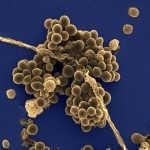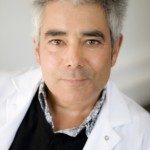Link to Pubmed [PMID] – 8581163
Microbiology (Reading, Engl.) 1996 Jan;142 ( Pt 1):173-80
The Gram-positive bacterium Listeria monocytogenes can actively induce its own uptake by epithelial cells and fibroblasts through a surface-exposed 80 kDa protein, internalin (InIA), encoded by inIA. We studied the distribution and the DNA polymorphism of inIA sequences in a wide variety of wild strains of L. monocytogenes as compared to other Listeria species. This was done by PCR-amplifying inIA sequences encoding the fifteen repeats A and the three repeats B of InIA. inIA-repeated sequences were only found in L. monocytogenes. The amplified fragment of inIA encoding the repeats A displayed an AIuI DNA polymorphism which arises from point mutations. These results indicate that inIA required for cell invasion is specific to L. monocytogenes and that the intragenic repeats only exhibit a genetic heterogeneity due to point mutations and not to recombinations.

